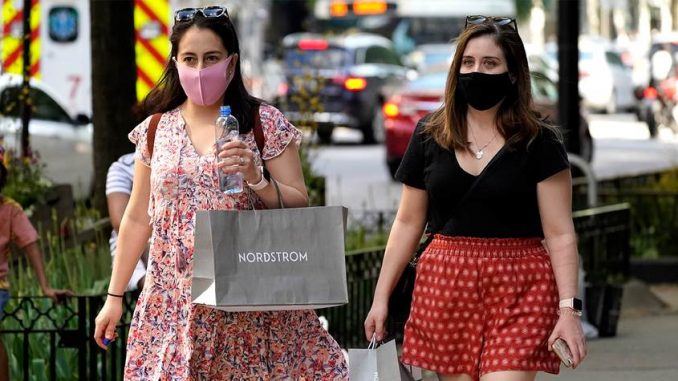
The good news for retailers is that a strong holiday shopping season is expected this year. The bad news is an expectation of limited inventories, longer shipping times, labor shortages, and fewer discounts. Blame “Containergeddon.”
More than 60 container ships carrying clothing, furniture and electronics worth billions of dollars are stuck outside Los Angeles and Long Beach terminals, waiting to unload, according to the Marine Exchange of Southern California.
Pre-pandemic, it was unusual for more than one ship to be in the waiting lane at the No. 1 U.S. port complex, which handles more than half of all American imports.
Retail consultancy groups note that 20-25% of the goods stuck on ships were unlikely to make it onto shelves in time for November 26 Black Friday kickoff. Retailers typically count on that sales period to make about a third or more of their yearly profits.
Big retailers are chartering ships on their own to deal with shipping delays brought on by the pandemic-driven slowdown of sea networks. Container ships from overseas handle 90% of the world’s trade. Shipping delays mean a lack of inventory and consumers may be facing sparsely stocked shelves for some items this year. Walmart and Home Depot are two big retailers who are finding alternate ways to get their goods delivered so that stores are stocked.
In a typical year, Walmart would have moved those toys from China to Los Angeles in hundreds of 40-foot (12-metre) cargo boxes stacked like colorful Lego bricks on gigantic container vessels that serve multiple customers.
But 2021 is far from typical. Incoming cargo at the Port of Los Angeles is up 30% from last year’s record levels. Trucks and trains can’t remove it fast enough, leading to logjams, said the port’s Executive Director Gene Seroka, reflecting the surge in consumer demand.
“It’s like taking 10 lanes of freeway traffic and squeezing them into five,” Seroka said.
Chartered ships that offer valuable cargo space and can sidestep the container terminals play a critical role in this second pandemic holiday season, particularly for time-sensitive goods like Christmas sweaters that won’t sell if they arrive too late.
Retailers don’t expect the shipping problems to ease until well into 2022. This means it’s time to get holiday shopping done now if you can in order to avoid sparsely stocked shelves later. Prices are likely going up, too. Dollar Tree, a popular bargain retail chain, for instance, recently announced that some items will be priced at more than one dollar now. Big retailers stocked up early this year as the country moved out of strict pandemic lockdowns.
Big retailers stocked up earlier than usual this year as the U.S. tried to emerge from the pandemic. Target, for example, had 26% more inventory at the end of June than it did in 2020, at the height of store closures. The retailer ordered earlier — and in bigger quantities ahead of the holidays — to make sure shelves were stocked and able to be replenished, John Mulligan, Target’s chief operating officer, told investors in August.
For its part, Amazon is “confident in our ability to serve customers this holiday season,” a spokesman said. The retail giant said it’s “on track” to hire 125,000 more people in warehouse and logistics jobs.
Smaller retail stores will feel the pinch. Goods they order are arriving but the lead times are longer and that results in sparsely filled shelves. Decisions have to be made if additional costs to the stores to keep up shipments will be passed down to its customers. There is also higher U.S. Postal Service shipping rates and a delivery slowdown to factor in.
Popular clothing items like Nike sneakers are taking twice the time to come from Asia to North America. The process before the pandemic took about 40 days from the time the order was made. Container shortages, shipping congestion, and labor shortages have caused the process to take 80 days now. Department stores had to make contingency plans with vendors earlier than usual this year.
Expect to pay more for some Christmas holiday basics, like a Christmas tree. Tree growers advise customers to get out early to buy a tree. Bah humbug.
Live tree costs have roughly doubled since 2015, according to a report from the U.S. Department of Agriculture, while artificial tree prices are up 20% to 30%, the holiday tree group said.
Fires, drought and heat waves, exacerbated by climate change, decimated the yield of some tree crops. Some Oregon farmers lost up to 90% of their crop, according to the group.
“We hope that every person who wants a Christmas tree will find their perfect tree this year,” Jami Warner, the ACTA’s executive director, said in a recent statement. “If I can give one piece of advice to consumers right now, it is to find and buy your Christmas tree early.”
The global transportation bottleneck may also produce a toy shortage. Toymakers warn that they will be more expensive this year and harder to find. Massive labor shortages due to COVID-19 and supply shortages were worsened by the Suez Canal blockage in March. It all has a chain effect with the shipping containers sitting in California ports adding to the problems.
Retailers will be hit hard if merchandise isn’t on shelves in time for holiday shopping, as sales plummet significantly after the December 25 deadline. It will also negatively impact toy companies, which will find it difficult to move more inventory when retailers still have warehouses full of it.
Salesforce predicts a 20% increase in prices this holiday season, and according to Today, KPMG expects a 7% increase in holiday sales for U.S. retailers, almost double the historical annual growth rate. That means shoppers must get in early if they want to find the gifts on their lists.
“If your kid has their heart set on something, go buy it now,” said Steve Pasierb, CEO of the Toy Association. “Don’t wait.”
We are being warned. Plan accordingly.
Via Hot Air
